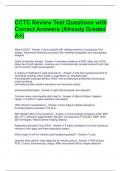CCTC Review Test Questions with
Correct Answers (Already Graded
A+)
What is DSA? - Answer ✔ donor specific AB -reflects reactivity to a particular HLA
antigen. Determines likelihood of positive XM. Identifies acceptable and unacceptable
antigens
Goals of induction therapy - Answer ✔ decrease incidence of DGF, delay use of CNI,
delay risk of graft rejection, minimize use of corticosteroids, provide intense IS with high
risk for acute or hyper acute rejection
3 classes of medications used post heart tx - Answer ✔ CNI (tac/cyclosporine)-bind to
intracellular proteins which leads to suppression of t celymphocytes
Antimetabolite (cellcept/myfortic)-inhibit t and b lymphocyte proliferation by blocking
purine synthesis
corticosteroid-alter cytokine expression and leukocyte activity
endomyocardial biopsy - Answer ✔ right internal jugular vein approach
Coronary artery vasculopathy after heart tx - Answer ✔ affects children, happens
rapidly, in months in cases treatment-retransplant
CMV infection manifestations - Answer ✔ fever fatigue malaise leukopenia
thrombocytopenia elevated LFTs GI sx
EBV (Epstein-Barr Virus) symptoms - Answer ✔ mononucleosis symptoms (CBC, EBV
AB, LFTs, Heterophil aggluntination AB test) -Consequence PTLD(CBC, BMP, CMV,
EBV serologies, Head to pelvis imaging, Biopsy)
Respiratory Syncytial Virus (RSV) - Answer ✔ A highly contagious virus that causes an
infection of the upper and lower respiratory system.
Which organ is risk for infection post transplant greatest? - Answer ✔ Lung-
sensitive tests used for early diagnosis of infection post tx - Answer ✔ DNA probes,
PCR, Ct scan, bronchoscopy, biopsy, MRIs monoclonal AB for antigen detection
,Most reliable indication of CNS infection - Answer ✔ Simultaneous presence of
unexplained fever and headache because changes in LOC may be subtle. Warrant
immediate neurological exam and assessment
Preferred test to dx CMV - Answer ✔ CMV RNA or DNA-indicative of active infection
CMV prophylaxis - Answer ✔ Valganciclovir/Valcyte (monitor leukopenia) 3-6 mos,
except for Lung 12 mos
Gancyclovir /cytovene Oral & IV (monitor leukopenia and disease resistance
CMV treatment - Answer ✔ Gangciclovir(IV only), valganciclovir
Valacyclovir-Kidney only (Neurotoxic)
BK virus risk factors - Answer ✔ Older, male recipient, stents, low BK titers, HLA
mismatch, deceased donation, female donor, high BK iris specific AB titers
Sx of BK virus - Answer ✔ fever, hematuria, elevated creatinine
BK virus screening - Answer ✔ every 3 months first 2 years then annually until 5th post
tx year
Gold standard for BK virus dx - Answer ✔ Biopsy
JC virus (Polyomavirus) - Answer ✔ Affects brain, CNS clinical manifestations (classic
triad dementia, hemiparesis, hemianopsia) Treatment steroids, interferons,
Risk factors Lung infection post tx - Answer ✔ impaired cough reflex, poor mucosal
clearance, abnormal lymph drainage, single lung tx, airway inflammation, ischemia and
perfusion injury, CF
Sx of pneumonia in heart or lung tx - Answer ✔ persistent respiratory failure, failure to
wean from vent, fever, purulent secretions, lung consolidation
Dx respiratory tract cx, CT scan
cholangitis - Answer ✔ bile duct infection. Sx Fever, leukocytosis, RUQ pain, Rebound
tenderness, high bilirubin, high transaminases, high all phos. Chongiogram, LFTs too
diagnose.
Treatment-Obstruction-ERCP w/dilation. No obstruction-Abx
Prevention-antimicrobial prophylaxis before any manipulation of biliary tract
Lymphocele post kidney tx - Answer ✔ collection of fluid between bladder and allograft.
Sx-fever, graft tenderness, unilateral leg edema on side of transplanted kidney,
incontinence, decrease uo, decrease kidney function, increase BUN/creatinine
, treatment-drainage
How is toxoplasmosis diagnosed? - Answer ✔ endomyocardial biopsy
Cryptosporidium parvum - Answer ✔ Protozoan parasite transmitted by contaminated
water, causes severe, persistent watery diarrhea
Avoid well water, boil water x1 minute, bottled distilled water, avoid ice cubes, fountain
dfroinks made with tap water, use water filter
Drug interactions/side effects - Answer ✔ antimicrobials can increase/decrease tac or
cyclosporine levels and cause added nephrotoxicity
OPTN Policy 15.1 Identification of transmissible disease - Answer ✔ Each program
must have pt safety contact available 24hrs/day, receive notification from UNOS of
potential disease, communicate to recipients medical staff ASAp, no later than 24hrs,
facilitate communication about clinical status of recipient
OPTN policy 15.2 potential candidate screening requirements - Answer ✔ potential
candidate tested for HIV, Hep B, Hep C and offered counseling if positive
OPTN policy 15.3 Informed consent of Transmissible Disease Risk - Answer ✔ Program
obtains specific informed consent if donor has known medical condition that bis
transmissible, donor meets criteria for increased risk of transmitting HepB, C, HIV
OPTN policy 15.5A post Tx discovery of donor disease or malignancy - Answer ✔ Notify
OPO or LD recovery hospital, notify recipients of risk or confirmation, document in
recipients medical record, follow notified recipients for disease or malignancy, offer
recipients additional testing , monitoring, and treatment in addition to routine f/u care.
OPTN 15.5B Discovery of recipient disease or malignancy - Answer ✔ Notify OPO or
LD recovery hospital by phone of findings ASAp within 24hrs. Report event thru UNOS
pt safety portalASAp w/n 24 hrs of learning of event. provide additional info or
specimens as requested.
OPTYN Policy 15.5C Post reporting follow up - Answer ✔ submit relevant test results,
respond to requests for info, provide updated info contribute to follow up review
Procedure for liver transplant - Answer ✔ Anastomosis of the inferior vena cava, portal
vein, hepatic artery, and the biliary connection via a duct to duct anastomosis (
choledochocholeclochostomy)
Etiology of renal dysfunction immediately post op(liver tx) - Answer ✔ Hypotensive
episodes, blood loss, high renal vein pressure intraoperatively and postoperatively due
to hemodynamically instability or sepsis.




